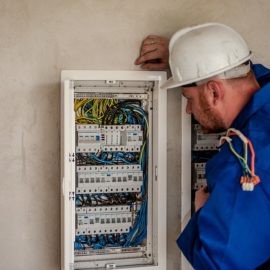
Nothing brings the household together quite like an unexpected electricity outage. While playing board games under candlelight can make for a fun experience, power faults are no joke.
An electricity power outage can occur without warning and can be stressful if you don’t know the proper steps to getting out of the dark. To make things easier, this article presents some electricity outage information to help you know what to do when the power is out.
What Are Outages?
An electricity outage is described as a short or long-term loss of electric power in a certain area. Electricity faults are broken down in three different categories based on the duration and outcome of the outage:
Permanent fault: A substantial power shortage from a fault on a power line, with energy automatically restored once the fault is cleared.
Brownout: A temporary drop in voltage in an electrical power supply.
Blackout: The total loss of power to an area, which can last from minutes to weeks depending on the severity.
For power faults to be considered a major electricity outage, they must conform to three criteria:
- The service provider cannot have planned the outage.
- At least 1,000 people must be affected and it must last at least one hour
- There must be at least 1,000,000 person-hours of disruption.
Globally, the biggest electricity outage in history occurred on the 31st of July, 2012, when 620 million people in India were without power until the next day. The electricity faults were due to three of the country’s five electricity grids failing, as they couldn’t meet the growing needs of the people.
In Australia, 170,000 homes lost electricity after Cyclone Yasi hit communities on the 3rd of February, 2011 and caused widespread damage. On a separate occasion, power was cut to 200,000 people in Victoria after bushfires caused the electricity connection to the national grid to shut down in 2007.
Five Common Causes of Power Outages
When looking at electricity outage information, there are some common themes for what causes electricity faults.
Weather – Australia’s weather can be a real problem when high winds or flying debris damage power lines or cause them to touch and short out. Heavy rain and flooding can also damage electrical infrastructure.
Spikes – a temporary increase in the electrical supply voltage can result in a power outage. These are usually caused by lightning strikes, tripped circuit breakers or short circuits.
Vehicles – motoring accidents resulting in broken poles or causing power lines to touch, can lead to an outage.
Bushfires – in a bushfire emergency, electricity supplies are often disconnected to ensure everyone’s safety.
Animals – different animals coming in contact with pieces of equipment, such as transformers and fuses, can cause it to shut down. This happened when a six-foot snake got zapped after slithering into a Gadsen electrical substation, causing a two hour outage.
What To Do if There’s A Power Outage
When the power goes out, it might be your first instinct to call your retailer. While your retailer sells the electricity to homes and businesses across the country, they are purchasing it from wholesale electricity distributors. These local distributors own and operate the poles, wires and meters so they should be your first port of call.
While your retailer can assist by putting you in contact with the right people to get your power back up and running, they cannot do as much as distributors. Your distributor will have the ability to send someone, like the experts at Peninsula Heating Cooling & Electrical P/L to examine if there is a supply issue or fault.
Alternatively, during an outage they can provide you with info on when power should return.
If the outage is widespread, the phone lines could be busy with many people calling for information. In this case, distributors will often have a pre-recorded message offering the most up-to-date information.



